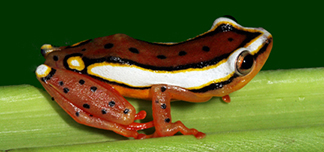| Publication Type: | Journal Article |
| Year of Publication: | 2006 |
| Authors: | F. J. J. Chain, Evans B. J. |
| Journal: | PLoS Genetics |
| Volume: | 2 |
| Pagination: | 478-490 |
| Abstract: | Gene duplication provides a window of opportunity for biological variants to persist under the protection of a co-expressed copy with similar or redundant function. Duplication catalyzes innovation ( neofunctionalization), subfunction degeneration ( subfunctionalization), and genetic buffering ( redundancy), and the genetic survival of each paralog is triggered by mechanisms that add, compromise, or do not alter protein function. We tested the applicability of three types of mechanisms for promoting the retained expression of duplicated genes in 290 expressed paralogs of the tetraploid clawed frog, Xenopus laevis. Tests were based on explicit expectations concerning the ka/ks ratio, and the number and location of nonsynonymous substitutions after duplication. Functional constraints on the majority of paralogs are not significantly different from a singleton ortholog. However, we recover strong support that some of them have an asymmetric rate of nonsynonymous substitution: 6% match predictions of the neofunctionalization hypothesis in that ( 1) each paralog accumulated nonsynonymous substitutions at a significantly different rate and ( 2) the one that evolves faster has a higher ka/ ks ratio than the other paralog and than a singleton ortholog. Fewer paralogs ( 3%) exhibit a complementary pattern of substitution at the protein level that is predicted by enhancement or degradation of different functional domains, and the remaining 13% have a higher average ka/ ks ratio in both paralogs that is consistent with altered functional constraints, diversifying selection, or activity-reducing mutations after duplication. We estimate that these paralogs have been retained since they originated by genome duplication between 21 and 41 million years ago. Multiple mechanisms operate to promote the retained expression of duplicates in the same genome, in genes in the same functional class, over the same period of time following duplication, and sometimes in the same pair of paralogs. None of these paralogs are superfluous; degradation or enhancement of different protein subfunctions and neofunctionalization are plausible hypotheses for the retained expression of some of them. Evolution of most X. laevis paralogs, however, is consistent with retained expression via mechanisms that do not radically alter functional constraints, such as selection to preserve post- duplication stoichiometry or temporal, quantitative, or spatial subfunctionalization. |
